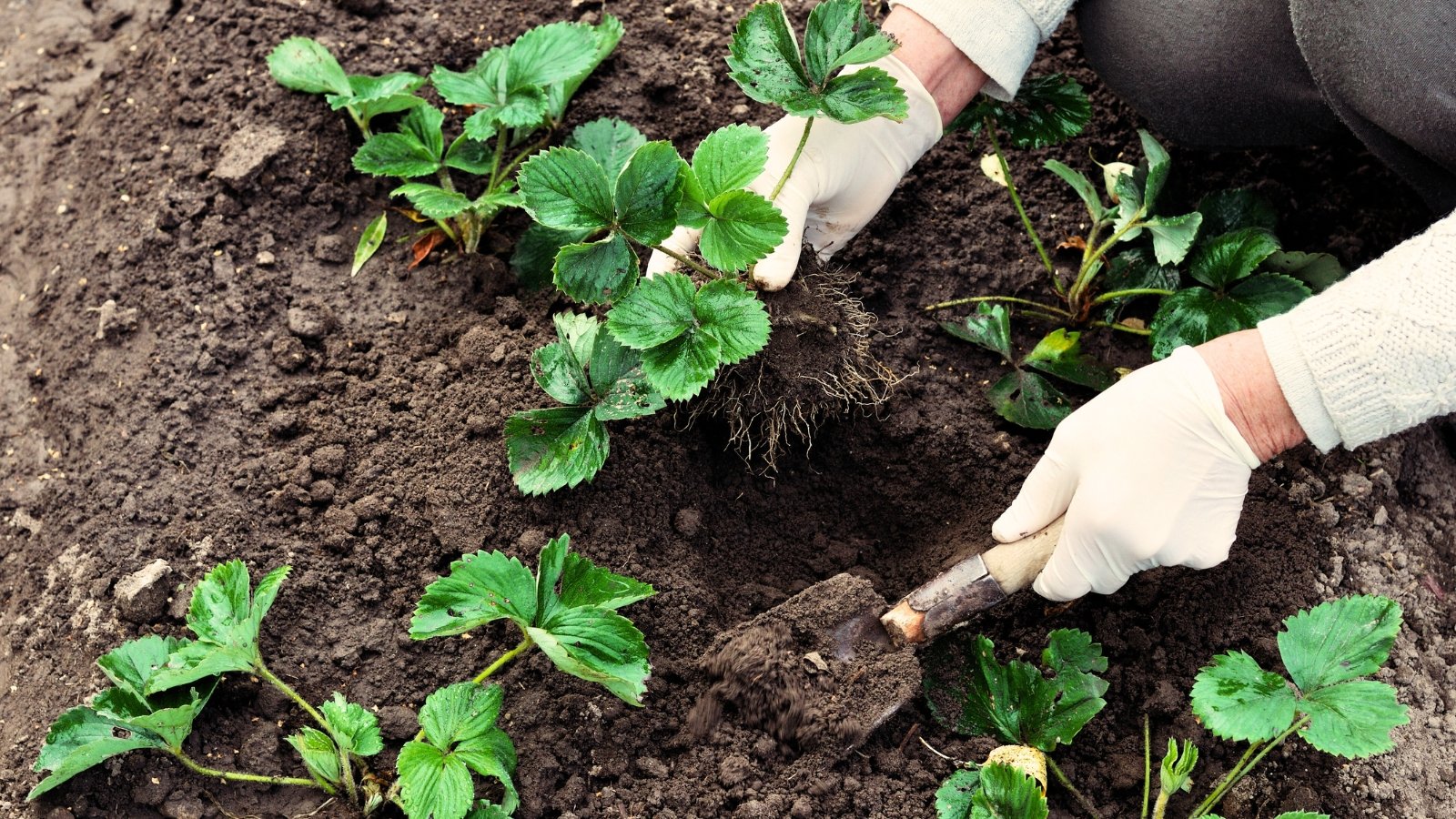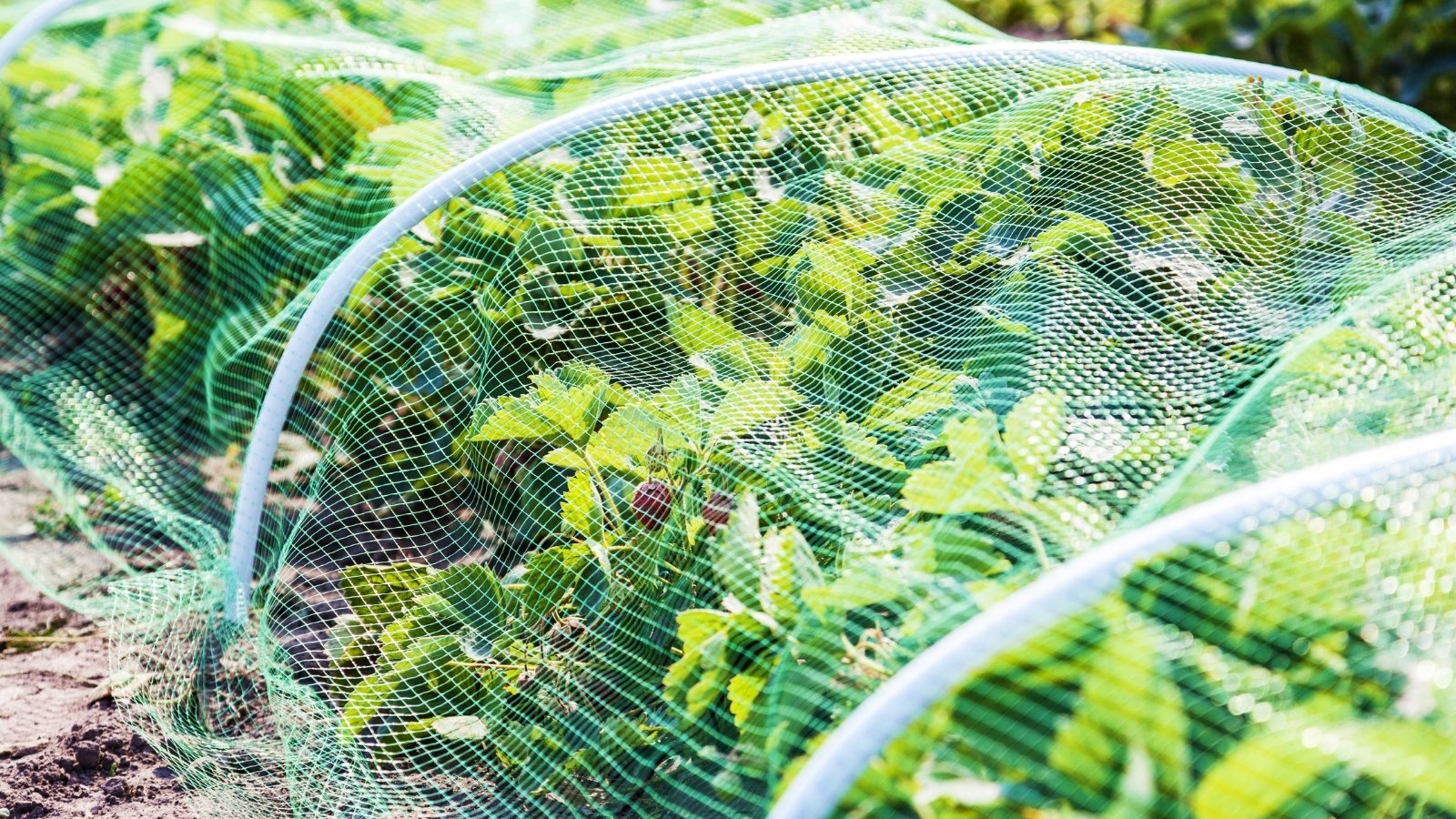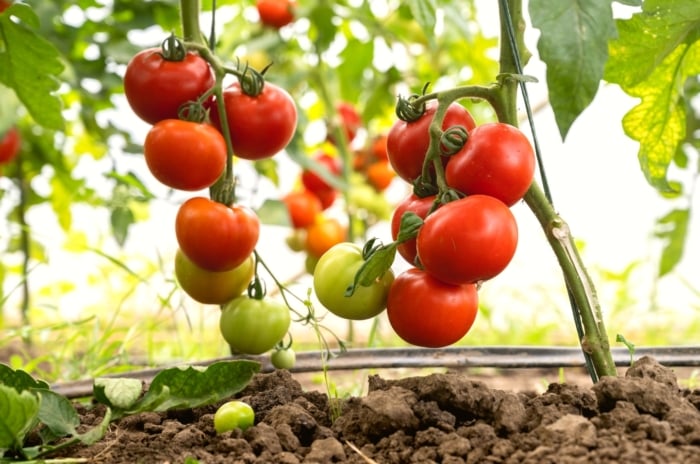How Much Sun Do Strawberries Need?
If your strawberry plants are small, pale, and low-yielding, they may not be getting enough light. Former organic farmer Logan Hailey explains exactly how much sunlight strawberries need to thrive.

Contents
Your favorite bright red berries can grow all summer long in raised beds, containers, or hanging baskets as long as they have the proper light, soil, and water. Some varieties produce copious amounts of sweet fruit all summer long. However, if your strawberries are not planted in an area with sufficient sun, they may not have the energy they need to flourish.
Let’s dig into exactly how much sunshine garden strawberries need and how to determine if your plants are getting too much or too little light.
The Short Answer
Strawberries need 6 to 8 hours of direct sun per day to grow healthy foliage and yield high quantities of fruit. They thrive in full sun and struggle to produce flowers and fruits in the shade. For the most fruit, grow strawberries in the sunniest south-facing part of your garden, away from larger vegetables, shrubs, and trees. They can tolerate partial shade but may not produce as much fruit. Wild strawberries (Fragaria virginiana) are an exception to this rule, as these native groundcover plants can thrive in partial shade that mimics their wild environment.
The Long Answer
Strawberries are small, herbaceous, fruiting plants that belong to the Rosaceae (rose) family. Depending on the variety, strawberries can produce fruit throughout the frost-free season and grow as annuals or overwintering perennials in zones 4 through 9.
Native to North America, these famous berries originated as wild, trailing plants growing in the partially shaded edges of temperate forests. Over the past few centuries, humans have cultivated Fragaria species for larger berries, sweeter flavors, and higher agricultural productivity. With all these changes, you can imagine that modern varieties of strawberries have very different needs than their wild ancestors.
Cultivated strawberries require more sunlight because the berries are large and produced in large quantities. Sun exposure directly impacts when and how the plants flower and fruit. Without sufficient light, these low-growing berries cannot produce enough energy in their leaves to maintain healthy foliage, roots, and fruits. Here is how to diagnose light-related issues in strawberries and ensure your plants are getting enough sun.
What Happens if Strawberries Don’t Get Enough Sun?

Strawberry plants grown in shady conditions are small, pale, stunted, and low-yielding. They have faded or yellow foliage due to a lack of chlorophyll, which is the green pigment produced in plant leaves.
Because they don’t have enough light to properly photosynthesize, the plants may never flower or produce the fruits you crave. If a strawberry isn’t getting the sunlight it needs, you may have to transplant the crown or move the container to a brighter location.
Symptoms of Low Light

Herbaceous sun-loving plants display very obvious clues when they aren’t getting enough sunshine. The key symptoms of insufficient sunlight include:
Pale leaves
Plants cannot produce as much chlorophyll (green pigment) in low-light conditions.
Yellowing foliage
Lack of photosynthesis often makes leaves turn yellow in the shade.
Slow growth
Stunting and slow growth occur because the leaves aren’t getting enough energy from the sun.
Lack of flowers
Plants struggle to survive in the shade and lack the energy to produce flowers.
Lack of fruit
Without flowers, there are no fruits.
In contrast, healthy strawberry plants have verdant green leaves and rapid growth. As long as the plants are mature and the weather is warm, there should be lots of white flowers and developing or ripening fruit.
Some light symptoms may look similar to nutrient deficiencies and diseases. For example, yellowing is a universal plant signal that something is wrong. You can tell the difference between low light and nutrient deficiencies by looking closer at the leaves. An overall pale appearance on all the leaves indicates a lack of sunlight.
In contrast, nutrient deficiencies tend to appear on only the older or newer leaves, depending on the nutrient. Diseased plants display other symptoms like powdery fungal growths, brown lesions, or red-hued foliage.
Full Sun vs. Partial Sun vs. Shade

Full-sun plants typically require a minimum of 6 to 8 hours of direct sunlight per day. Even if the sky is cloudy, these plants can still photosynthesize under an open sky without the shade of other plants. Cultivated strawberries are full-sun plants that struggle to grow properly if they’re left in the shadows.
Although they are low-growing and often used as ground cover, strawberry plants fruit best with direct sun exposure. If you want to grow them only for their foliage, it is fine to keep the groundcover vines under the partial shade of trees and shrubs.
Partial sun or partial shade plants only need 4 to 6 hours of direct sunlight per day. They can survive in east-facing or west-facing orientations where they only receive direct sun rays in the morning or afternoon.
Full shade plants can get by on 3 to 5 hours of indirect sunlight per day, or the dappled rays of sunshine through a canopy of trees. Most garden vegetables and fruits are full sun or partial sun plants, and they will suffer in full shade. Strawberries are unlikely to survive, let alone fruit, in fully shaded conditions. Ornamentals like ferns, hostas, and wild ginger can tolerate full shade in the understory of a forest garden.
Understanding Solar Aspect

Strawberries do best in a south-facing orientation in the front of your garden. Because they are low-growing, it’s important to observe nearby structures, trees, and shrubs that may cast shadows at different parts of the day. A few shadows are fine, but too much shade can hinder strawberry production. If your yard gets a lot of shade, consider growing strawberries in hanging baskets from a sunny porch or patio.
Summer sun is obviously the most important for these warm-weather crops. In most climates, strawberries go dormant in the cold months and overwinter underground, ideally beneath a layer of thick mulch. Sun exposure is not important in the winter, but it dramatically affects how quickly the plants rejuvenate and start flowering in the spring.
South-facing full sun beds thaw and warm up more quickly with the spring sunlight. Moreover, raised beds warm up the fastest because the soil is lifted above the ground, and sun rays hit the outside of the wooden or metal structure to warm it up. The result is earlier strawberry yields from raised beds.
Ultimately, solar aspect is a vital and simple concept for every gardener to understand. It describes how the sun hits your garden at different angles during different times of the day and months of the year. If you’ve noticed that the sun is lower in the sky during the fall and winter, you already have a basic grasp of solar aspect. Similarly, you can observe how an east-facing garden bed receives predominantly morning sunlight, and a west-facing bed is sunnier in the afternoon.
This all relates to the Earth’s rotation around the sun and the angle of the Earth’s axis during different seasons. The references we make here refer to the Northern Hemisphere, so you may need to adjust your sun exposure if you live in other parts of the world. For example, a south-facing garden is ideal in the Northern Hemisphere because it receives the most sun. But a north-facing garden gets more sunshine in the Southern Hemisphere.
5 Steps to Fix Insufficient Light in Strawberries
If your plants are pale and slow-growing, there is still time to help them regenerate so you can enjoy a summer of ripe, tasty berries. The best time to fix sunlight issues is shortly after planting. Young plants are adaptable and easy to move.
Identify the Problem

If your strawberries aren’t getting the sunlight they need, the plans will tell you fairly quickly. Remember that insufficient lighting is most recognizable by pale foliage and slow growth. All of the leaves will look pale and light-colored, and the plants will be stunted.
In contrast, yellowing on just the older leaves or the newer leaves is more likely a sign of nutrient deficiency. Sun exposure issues are the easiest to spot if one plant in a sunnier area is twice the size of a plant just a few feet away.
Newly planted strawberries can be more difficult to diagnose. Don’t get transplant shock symptoms confused with low light. Some plants (particularly seedling starts) may look yellow or droopy right after planting if they are having a hard time adjusting to their new home.
If you recently planted bare root crowns and they are taking a long time (more than two to three weeks) to grow new leaves, they may not be getting enough sun, or the crowns may be buried too deep, rotten, or dead. Check for buds or any signs of green growth in the crown before continuing.
Choose a Brighter Location

Once you’ve determined that lighting is the main issue, it’s time to find a brighter space. Strawberries do best in south-facing areas with direct sun and no tall plants in front of them. They do great in a 15” deep raised bed because their roots don’t grow super deep. If your garden is already full, you may need to move the plants to containers. These berries grow excellently in pots, planters, and hanging baskets.
Prepare the bed or container with a loamy, well-drained soil blend. Ensure there is lots of compost and organic matter. Check that the bottom of the container has holes for drainage so your plants don’t get waterlogged or soggy.
Transplant the Crowns

It is very easy to move your strawberry plants to a place that meets their sunshine needs. Fortunately, these plants are not super finicky about root disturbance and can recover fairly quickly after a move.
Use a shovel or trowel to dig around the circumference of the plant and carefully lift it from the ground. Grasp the plant from the base of the crown to pick it up. Use this opportunity to inspect the roots and crown for any signs of rot or disease. Rotten roots look mushy and yellowish-brown, whereas healthy roots are tan-colored, firm, and fibrous.
Dig a hole a little deeper than the root ball in the new bed or container. Place the strawberry inside, taking particular care to ensure the right depth. The crown should only be partially buried. If you plant strawberries too deep, they may succumb to crown rot and die. Check that the roots are fully covered, the soil line is in the middle of the crown, and all the leaves and stems are above the surface.
Backfill the soil around the plant and lightly press down to secure it in place. Water generously to help the plant root in its new home.
Protect Plants from Sunburn

It may seem silly to protect sun-loving plants from sunburn, but the leaves are fragile when moving to a new location. If your strawberries are moving from a very shaded area to a very bright area, they will likely need some protection to help them adjust. While these plants love full sunlight, they can still get sunburnt if they experience a drastic move. The same thing would happen to you if you spent all winter indoors and then lay in the tropical sun for hours on end without protection.
The best way to prevent sunburn in strawberries is to cover them with a light layer of row fabric or shade cloth. Agricultural row fabric is a white semi-translucent material that allows sunshine and water through but keeps pests and harsh weather extremes out. Shade cloth is usually black with small perforations in the fabric. Both options work well to prevent sunburn, but row cover is usually best for cold climates, and shade cloth is better for hot areas.
Drape the layer of fabric over the strawberries in their new location and secure it with smooth rocks or sandbags to hold down the edges. Leave the fabric in place for a week or so until the plants show signs of new growth and greener, healthier leaves.
Sunscorch may cause dark yellow or brown leaves, making the plant’s health worse rather than better. Be very careful when moving shaded plants to sunnier areas. Strawberries are adaptable, but they prefer gradual changes. If you don’t have row fabric or shade cloth, you can move the container closer to the full sun area over the course of a week.
Look for Signs of Healthy Regrowth

It can take two to three weeks for a plant to fully recover from transplanting. Ensure consistently moist (but never soggy) soil and wait patiently. Signs of success and healthy regrowth include:
- Greener leaves (paling or yellowing is mostly gone)
- Growth of new buds and leaves
- Emerging flowers
- Upright stature (the leaves are erect and reaching up toward the sun)
- New runners or shoots
- Faster growth
Final Thoughts
If your strawberry leaves lack green color and red fruits, lack of sun could be the issue. Pale foliage is the main indicator that plants aren’t getting enough light. Insufficient sun also causes slow growth, lack of flowers, and no fruit.
To fix the issue, transplant your strawberry crowns to beds or containers with more sunshine. Ensure a gradual shift by using row fabric or shade cloth to protect from sun scorch. In the future, plant all strawberries in south-facing areas without shade from nearby trees or structures.








